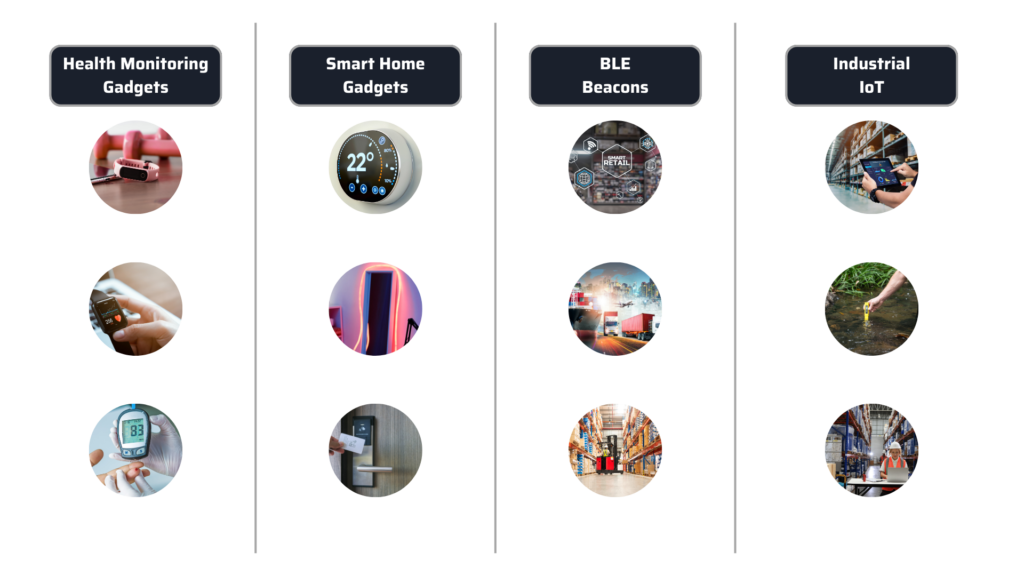Integration of BLE in Embedded Systems
The rise in battery-operated gadgets has made conserving energy a crucial need, demanding a solution that reduces the need for constant battery charging/changes. BLE has become the best choice for short-range, low-power applications as it can transmit small amounts of data using quite low energy. In contrast to Classic Bluetooth, BLE was specifically created to ensure consistent communication with much lower power consumption, making it a crucial component for IoT applications, healthcare devices, and smart home solutions.
Bluetooth Low Energy (BLE), also known as Bluetooth Smart device, is a wireless communication standard created for short-distance and low-power data transmission. Back in the days, BLE (called Bluetooth 4.0 standard) operated on the 2.4 GHz ISM band just like the classic Bluetooth, also known as Bluetooth BR/EDR. However, it differs in energy efficiency and data transmission methods. Classic Bluetooth was created for streaming data constantly and for high-bandwidth tasks such as wireless audio and transferring large data files, whereas BLE was specifically designed for low-power connectivity/communication.
Integration in Embedded Systems
The incorporation of BLE technology in embedded systems is becoming more essential in different sectors due to the rising need for interconnected devices. BLE’s distinct structure allows companies to improve their range of products, adding value for both customers and businesses. One of the main benefits of BLE is its capability to support a wide range of applications while maintaining power efficiency. This adaptability is especially attractive to manufacturers striving to innovate and comply with the strict energy needs of current devices.
The BLE Audio is considered a breakthrough. This development in the smartphone market enables users to share audio with multiple wireless headsets from one device, improving functionality and user involvement.
However, achieving this integration requires careful consideration of the hardware, software, and communication protocols.
Hardware Considerations:
- Microcontroller Unit selection: Modern microcontrollers often feature integrated BLE modules or support BLE-compatible chipsets, simplifying integration.
- Antenna design: The performance of BLE systems is driven by antenna design. A well-optimized PCB antenna enhances signal integrity and range while minimizing the physical footprint.
- Power management: Efficient power management is essential for leveraging BLE’s low-energy capabilities. Components like low-dropout regulators (LDOs) and capacitors play a crucial role in maintaining low-power characteristics.
Software and Stack integration:
- BLE Stack: Integrating BLE involves managing a layered software architecture, known as the BLE stack, which handles physical, link, and application layers to ensure secure data transmission and connection management. Many BLE chipsets come with pre-certified stacks, easing compliance with Bluetooth standards.
- Operating System: Lightweight operating systems like FreeRTOS with FPGAs/Microcontrollers are often used to provide real-time control while optimizing energy efficiency.
- Security: Given BLE’s use in consumer and industrial applications, secure communication is vital. BLE incorporates AES-128 encryption, but developers must focus on proper key management and secure pairing methods to prevent unauthorized access.

Use Cases of BLE
Applications of BLE in Embedded Systems
- Healthcare and Wearable devices: BLE is extensively utilized in health monitoring gadgets such as fitness trackers, heart rate monitors, glucose meters, and various others. These devices can run for extended periods using small batteries, maintaining dependable communication with smartphones or other central systems.
- Smart Home Automation: BLE is employed in smart home gadgets such as thermostats, lighting setups, door locks, and sensors. The capability of linking numerous devices to one central hub or mobile application allows for effortless supervision and management while maintaining low power usage to ensure the longevity of battery-operated devices.
- Asset Tracking and Beacons: BLE beacons are utilized in retail, logistics, and asset management for delivering location-based services. Beacons send out data packets to nearby BLE-enabled devices, enabling businesses to monitor inventory, offer proximity-based marketing, or track the real-time whereabouts of valuable assets.
- Industrial IoT: In an Industrial IoT setting, one can monitor equipment, track assets, and perform predictive maintenance. BLE sensors can transmit information about the equipment’s condition or the environment to a central system, enabling effective monitoring without the need for continuous data streaming and minimizing energy usage.
The future outlook for BLE
The future for BLE in embedded systems appears optimistic as the need for energy-efficient, interconnected devices keeps increasing. The latest development in BLE may bring notable enhancements, including extended range, increased data transmission speeds, and improved broadcasting functions.
These developments enhance the appeal of BLE for upcoming uses in smart cities, healthcare, and IIoT. Additionally, with the world’s progression towards increasingly interconnected and intelligent ecosystems, the significance of BLE in facilitating smooth, energy-efficient communication will only grow. It is also anticipated that the integration of BLE with other wireless standards such as Zigbee and Wi-Fi in hybrid systems will increase its range of use.
At MosChip Technologies, we provide thorough expertise for the design, integration, and development of Bluetooth Low Energy (BLE) technology enabled solutions across diverse industrial applications. Our expertise encompasses hardware and embedded systems design, software development, BLE stack integration, firmware development, and the implementation of secure communication protocols to deliver impactful solutions.
Author
-
Ambuj is a Marketing professional at MosChip creating impactful techno-commercial writeups and conducting extensive market research to promote businesses on various platforms. He has been a passionate marketer for more than three years and is constantly looking for new endeavours to take on. When He’s not working, Ambuj can be found riding his bike or exploring new destinations.







